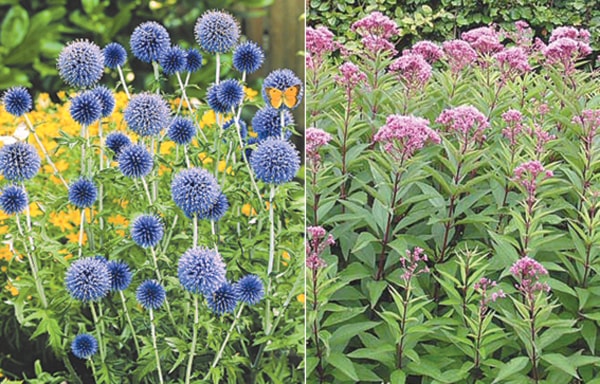Plants that go dormant in the fall, respond to shorter days by making preparations for winter.
The majority of these plants take on a sickly or old look. Their flowers and foliage begin to fade. There are a few perennials that are just starting to come into their own. These should be treasured as they extend the summer season in the garden.
Globe thistles, Echinops ritro, conjure up pictures of prickly noxious weeds when in reality they are anything but.
These mild-mannered perennials have large blue balls for flowers that last for a few weeks. The plants will grow up to 48 inches (120 cm) in height. Plant globe thistle in an area that has full sun or light shade.
Joe Pye weed, Eupatorium purpureum, is another plant with a common name that does not describe the plant. When planted in full sun with an unlimited amount of moisture and rich soil, the plant will reach the height of six feet (180 cm). Poorer soil and less moisture will result in smaller plants. The large pink flowers are very fragrant.
Sea holly, Eryngium planum, might reach 36 inches (90 cm) in height. The foliage and flowers turn a bright blue and will remain that colour if cut and dried. Sea holly, depending on the variety, can spread aggressively. It is best to purchase a named variety or to place in poor soil with some shade. It is also a great plant to cover in a large area in full sun.
Helenium are a flower that is available in yellow, gold, and red depending on the variety. Given time these plants will form huge colourful clumps. They prefer full sun and can reach a height of 48 inches (120 cm)
Golden glow or rebeckia are available in the traditional height of six feet (180 cm), or in newer shorter varieties. These yellow or yellow and orange flowers start blooming the last week in August and continue into October, or when they are covered with snow. Plant all varieties in full sun or light shade.
Phlox, the old fashioned type, that stands approximately three-feet (88-cm) tall and blooms late in the season. Plant in full sun with the plants far enough apart to ensure that air can circulate between the plant stocks. The flowers of garden phlox are available in pinks, purples, bi-colour and white.
Autumn joy is a large succulent. It needs to be placed in a hot location for it to flower before it freezes in the fall. The large pink flower resembles a loose pink cauliflower. Autumn joy will reach a height of two feet (59 cm)
Morden mums are a variety of mums or chrysanthemums that are hardy on the Prairies. The flowers are available in a variety of colours, pinks, yellows and bronze. Plant hardy mums in full sun in rich organic soil. Expect blooms on these flowers until the end of September.
Do not confuse hardy mums with the varieties that are sold in florist shops or ones that are to be placed in planters.
They will not survive the winter.
Hostas are usually thought of as a foliage plant as they have spectacular foliage. Many varieties also have attractive flowers that shoot upwards in a spike above the leaves. Hostas will grow in deep shade but many varieties will also do well in partial shade. Plants will grow larger if they are given a source of nutrients and moisture through out the growing season.
These are just a few of the plants that brighten up the landscape during September. Plant a few to add colour as once the last flower fades it is a long time until spring.
Linda Tomlinson is a horticulturalist and educator living in Rocky Mountain House. You can contact her at your_garden@hotmail.com
